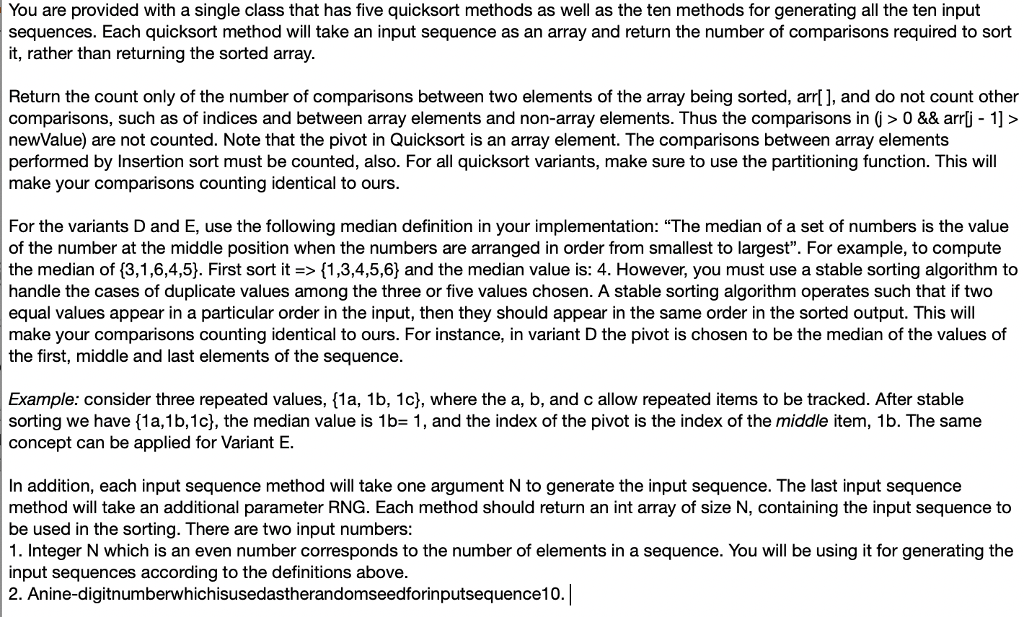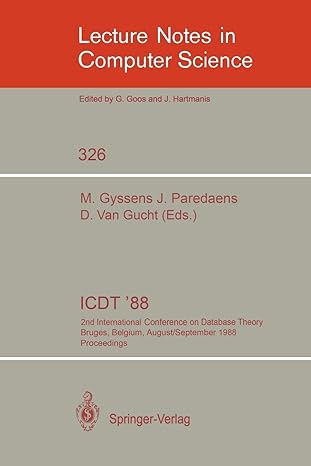Question
import java.util.*; public class QuickSort { public int QuickSortPivotA(int [] array) { /* Implement the quicksort with pivot as the last element of the sequence.
 import java.util.*;
import java.util.*;
public class QuickSort
{
public int QuickSortPivotA(int [] array)
{
/*
Implement the quicksort with pivot as the last element of the sequence.
The method to sort array in place in ascending order
the method is to return the number of comparisons required to complete the sorting.
*/
return 0;
}
public int QuickSortPivotB(int [] array)
{
/*
Implement the quicksort with pivot as the first element of the sequence.
The method to sort array in place in ascending order
the method is to return the number of comparisons required to complete the sorting.
*/
return 0;
}
public int QuickSortPivotC(int [] array)
{
/*
Implement the quicksort with pivot as the middle element of the sequence.
The method to sort array in place in ascending order
the method is to return the number of comparisons required to complete the sorting.
*/
return 0;
}
public int QuickSortPivotD(int [] array)
{
/*
Implement the quicksort with pivot as the median of the first, middle and last elements of the sequence.
The method to sort array in place in ascending order
the method is to return the number of comparisons required to complete the sorting.
*/
return 0;
}
public int QuickSortPivotE(int [] array)
{
/*
Implement the quicksort with pivot as the median of five elements of the sequence, chosen to be roughly 10%,
30%, 50%, 70% and 90% of the way through the sequence.
The method to sort array in place in ascending order
the method is to return the number of comparisons required to complete the sorting.
*/
return 0;
}
/*
*
* Implement the rest of the functions required to do the quicksort for every variation.
* */
public int[] GenerateInputSequence1(int N)
{
/*
* return an array with the sequence 1, 2, 3, ..., N (in increasing order).
* For example, if N = 1000, then the sequence would be: 1, 2, 3, 4, 5, ..., 1000
* */
return null;
}
public int[] GenerateInputSequence2(int N)
{
/*
* return an array with The sequence N, N-1, ..., 2, 1 (in decreasing order).
* For example, if N = 1000, then the sequence would be: 1000, 999, ..., 2, 1
* */
return null;
}
public int[] GenerateInputSequence3(int N)
{
/*
* return an array with The sequence 1, 3, 5, ..., N-1, 2, 4, 6, ..., N.
* For example, if N = 1000, then the sequence would be: 1, 3, 5, ..., 999, 2, 4, 6, ..., 1000
* */
return null;
}
public int[] GenerateInputSequence4(int N)
{
/*
* return an array with the sequence 1, 3, 5, ..., N-3, N-1, N, N-2, N-4, ..., 4, 2.
* For example, if N = 1000, then the sequence would be: 1,3,5 ...,997,999,1000,998,996, ..., 4,2
* */
return null;
}
public int[] GenerateInputSequence5(int N)
{
/*
* return an array with sequence 1, N, 2, N-1, 3, N-2, 4, N-3, ..., N/2, (N/2)+1.
* For example, if N = 1000, then the sequence would be: 1, 1000, 2, 999, 3, 998, 4, 997, ..., 500, 501
* */
return null;
}
public int[] GenerateInputSequence6(int N)
{
/*
* return an array with the sequence: Each number is (7 + the previous number) mod N.
* That is, a(i) = (7 + a(i-1)) mod N, a(0)=0
* For example, if N = 1000, then the sequence would be: 0, 7, 14, ..., 994, 1, 8, ..., 993
*/
return null;
}
public int[] GenerateInputSequence7(int N)
{
/*
* return an array with The sequence: The first N Fibonacci numbers modulo N:
* a(0) = 0; a(1) = 1; a(i) = (a(i-1) + a(i-2)) mod N for 1
* */
return null;
}
public int[] GenerateInputSequence8(int N)
{
/*
* return an array with The sequence The first N powers of 2 modulo N:
* a(0) = 1; a(i) = (2*a(i-1)) mod N for 0
* */
return null;
}
public int[] GenerateInputSequence9(int N)
{
/*
* return an array with The sequence: The first N powers of 3 modulo N:
* a(0) = 1; a(i) = (3*a(i-1)) mod N for 0
* */
return null;
}
public int[] GenerateInputSequence10(int N, int RNG_Seed)
{
/*
* return an array with The sequence N, N-1, ..., 2, 1 (in decreasing order).
* A random sequence using the methods in java.util.Random: Use setSeed(long seed) to set the seed using
* a nine-digit which will be an input to your method. Use nextInt()%10000 N times to get N random integers
* between -9999 and 9999. Use these in the order generated as the sequence.
* Example:Random generator = new Random();
* generator.setSeed(123456789); // 123456789 is example, seed will be input
* int num = generator.nextInt()%10000; // will be called N times to complete the sequence
* */
return null;
}
public static void main(String[] args)
{
/*
You can test you implementation of the quicksort here.
Please do not change the function names
*/
}
}
You are provided with a single class that has five quicksort methods as well as the ten methods for generating all the ten input sequences. Each quicksort method will take an input sequence as an array and return the number of comparisons required to sort it, rather than returning the sorted array. Return the count only of the number of comparisons between two elements of the array being sorted, arr[], and do not count other comparisons, such as of indices and between array elements and non-array elements. Thus the comparisons in (j>0&& arrj 1]> newValue) are not counted. Note that the pivot in Quicksort is an array element. The comparisons between array elements performed by Insertion sort must be counted, also. For all quicksort variants, make sure to use the partitioning function. This will make your comparisons counting identical to ours For the variants D and E, use the following median definition in your implementation: "The median of a set of numbers is the value of the number at the middle position when the numbers are arranged in order from smallest to largest". For example, to compute the median of {3,1,6,4,5). First sort it => {1,3,4,5,6) and the median value is: 4. However, you must use a stable sorting algorithm to handle the cases of duplicate values among the three or five values chosen. A stable sorting algorithm operates such that if two equal values appear in a particular order in the input, then they should appear in the same order in the sorted output. This will make your comparisons counting identical to ours. For instance, in variant D the pivot is chosen to be the median of the values of the first, middle and last elements of the sequence Example: consider three repeated values, fla, 1b, 1c), where the a, b, and c allow repeated items to be tracked. After stable sorting we have 1a,1b,1c), the median value is 1b 1, and the index of the pivot is the index of the middle item, 1b. The same concept can be applied for Variant E. In addition, each input sequence method will take one argument N to generate the input sequence. The last input sequence method will take an additional parameter RNG. Each method should return an int array of size N, containing the input sequence to be used in the sorting. There are two input numbers 1. Integer N which is an even number corresponds to the number of elements in a sequence. You will be using it for generating the input sequences according to the definitions above 2. Anine-digitnumberwhichisusedastherandomseedforinputsequence10.| You are provided with a single class that has five quicksort methods as well as the ten methods for generating all the ten input sequences. Each quicksort method will take an input sequence as an array and return the number of comparisons required to sort it, rather than returning the sorted array. Return the count only of the number of comparisons between two elements of the array being sorted, arr[], and do not count other comparisons, such as of indices and between array elements and non-array elements. Thus the comparisons in (j>0&& arrj 1]> newValue) are not counted. Note that the pivot in Quicksort is an array element. The comparisons between array elements performed by Insertion sort must be counted, also. For all quicksort variants, make sure to use the partitioning function. This will make your comparisons counting identical to ours For the variants D and E, use the following median definition in your implementation: "The median of a set of numbers is the value of the number at the middle position when the numbers are arranged in order from smallest to largest". For example, to compute the median of {3,1,6,4,5). First sort it => {1,3,4,5,6) and the median value is: 4. However, you must use a stable sorting algorithm to handle the cases of duplicate values among the three or five values chosen. A stable sorting algorithm operates such that if two equal values appear in a particular order in the input, then they should appear in the same order in the sorted output. This will make your comparisons counting identical to ours. For instance, in variant D the pivot is chosen to be the median of the values of the first, middle and last elements of the sequence Example: consider three repeated values, fla, 1b, 1c), where the a, b, and c allow repeated items to be tracked. After stable sorting we have 1a,1b,1c), the median value is 1b 1, and the index of the pivot is the index of the middle item, 1b. The same concept can be applied for Variant E. In addition, each input sequence method will take one argument N to generate the input sequence. The last input sequence method will take an additional parameter RNG. Each method should return an int array of size N, containing the input sequence to be used in the sorting. There are two input numbers 1. Integer N which is an even number corresponds to the number of elements in a sequence. You will be using it for generating the input sequences according to the definitions above 2. Anine-digitnumberwhichisusedastherandomseedforinputsequence10.|Step by Step Solution
There are 3 Steps involved in it
Step: 1

Get Instant Access to Expert-Tailored Solutions
See step-by-step solutions with expert insights and AI powered tools for academic success
Step: 2

Step: 3

Ace Your Homework with AI
Get the answers you need in no time with our AI-driven, step-by-step assistance
Get Started


